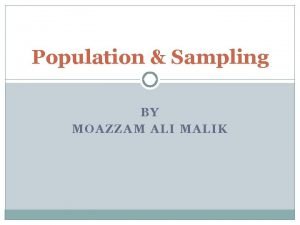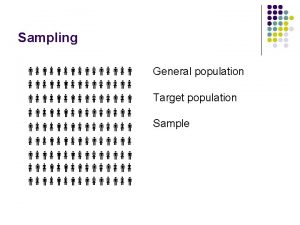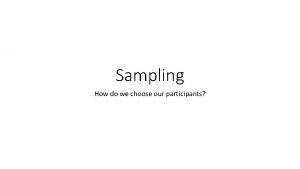SAMPLING OF PARTICIPANTS Population A population is a











- Slides: 11

SAMPLING OF PARTICIPANTS

Population A population is a group of people or animals with one or more characteristic in common. Example: the population of a country is all the people who live there, the population of internet users is ever one who can access the internet. A population could also be people who share a particular interest, such as ‘all football supporters’ or who have a particular feature, for example ‘all left-handed people’. Sample The sample is the group of people who participate in a study. They are taken fr/ a population and should ideally be representative of that group so that the findings will be representative. Details about the sample, such as age, ethnicity and gender, are important in most investigations because these features affect many psychological differences.

• Other characteristics of the sample, such as socio-economic status, education, employment, geographical location or occupation, may also be relevant. • The size of the sample also matters: • Small samples are less reliable and are likely to be less representative. • The different sampling techniques, or methods used to obtain the participants for a study from the population, produce samples which differ in terms of how well they represent the population. • The extent to which they are representative of the population determines how effectively generalizations can be made.

• Sampling Techniques • Opportunity Sampling – An opportunity sample is unlikely to represent the population fairly b/c readily available people will tend to be alike so they are unlikely to include the variety that exists. • Example: many studies are conducted using university students as they are convenient for the researchers. • This means that the results may not reflect the scores that people of different ages or educational opportunities might produce. • Despite this potential problem, opportunity sampling is the most common method, even for professional psychologists, as for many investigations the results are unlikely to be affected by age or education. • Opportunity samples may be biased as they will probably contain very similar people so are unlikely to include the spread of characteristics in the population.

• Volunteer (self-selected) sampling • Researchers may invite people to volunteer to participate in a study by putting up an advertisement, announcement or posting a request on the internet. • In this way, the people who respond and become participants choose to do so, i. e. are volunteers, so are described as a volunteer sample. • Because the individuals are self-selected, this sampling technique is unlikely to be representative of the population. • Volunteer may have more free time than average and, apart fr/ being willing, often have other characteristics in common, such as being better educated. • Nevertheless, it is a useful technique when looking for participants who are unusual in some way, • Example: Baron-Cohens’s study where people on the autistic spectrum were needed. • Volunteer samples may also be biased, containing similar people.

• Random sampling • In random sampling, each person in the population has an equal chance of being chosen, so the sample is much more likely to be representative. • Imagine you are looking for a sample of students at Killian and you put an advert for volunteers on the media center notice board. • Students who never go to the media center cannot be included so your sample might be biased towards those who work the hardest. • Similarly, if you took an opportunity sample from the common room, it would only include students who are relaxing • Now your sample might be biased towards the least hard working. • To obtain a representative sample you could instead use a numbered list of all students and use a random number generator to choose the participants. • This would be a random sample as any individual is equally likely to be chosen. • If the population is small, such as all members of a class, you can give each person a number, put pieces of paper with each number in a hat and draw out numbers until there are enough for your sample.

• Sampling techniques strengths and weaknesses • Opportunity sampling • Strengths: Quicker and easier as the participants are readily available. • Weaknesses: Likely to be non-representative – variety of people limited, tend to be similar so the sample could be biased. • Volunteer sampling • Strengths: Easy b/c participants come to researcher. Likely to be committed e. g. willing to return for repeat testing • Weaknesses: Likely to be non-representative. People who respond to request may be similar e. g. all have free time. • Random sampling • Strengths: Likely to be representative as all types in population equally likely to be chosen • Weaknesses: Everyone may not be equally likely to be chosen if they cannot be accessed. Particularly important if sample is small.

• Applying your knowledge of sampling techniques to novel research situations • An early step in any research is to obtain an appropriate sample. • The extent to which generalizations can be made from research depends in part on how representative the sample is. • It is important to get the best possible sample to be accurate. • However, practical constraints prevent researchers from using random samples most of the time and for many psychological phenomena, it is reasonable to believe that processes happen in a fairly universal way so some sample bias is unproblematic. • However, to assume there are no differences in emotional responses, cognitive processing or behavior btwn populations would be misleading. • The psychology of individual differences, of developmental psychology and crosscultural research are three areas specifically devoted to the study of such differences.

• It is therefore important that you can recognize limitations in the sampling technique used. • This means that you should be able to identify possible differences btwn individuals or groups that might matter for the particular phenomena being explored in a study. • Imagine two researchers at different universities are both studying obedience and both want samples from people nearby but not students. • One university is near a police college and the other is next to a hospital and the researchers both obtain opportunity samples with the same age and gender spreads from these workplaces. • Even though the samples are similar in age and gender, the difference in occupations may means that the results of their studies will be different – b/c police officers tend to be more obedient than nurses.

• You will need to be able to explain how you would use each sampling technique and to explain reasons for choosing each technique. • Example: Why it might be difficult to use a technique in practice, or why generalizations could or could not be made from the sample obtained.

• Research Methods in Practice • Your teacher has asked you to do a cognitive psychology investigation. You want it to work well so you want a sample of 30 people from which you can generalize. You think it would be easiest to take an opportunity sample from your classes at the college but you realize this might produce a biased sample as all your subjects are sciences. This might matter as the investigations is about using logic to solve problems and you think that science students might be especially good at the task. If so, their results might not be representative of the college population as a whole. A friend suggest making an announcement in the cafeteria asking for students studying all different subjects. This volunteer sampling technique might be better but there would be no guarantee of getting a range of people. You decide that the best sampling technique would be to choose individuals at random from a list of all the students in the college. You hope that this would means you would be equally likely to get students taking each subject. You decide to use this random sampling technique based on the students’ examination candidate numbers. You enter the candidate numbers into a random number generator and use the first 30 numbers that are generated.
 Perbedaan event sampling dan time sampling
Perbedaan event sampling dan time sampling Probability vs non probability sampling
Probability vs non probability sampling Cluster sampling vs stratified random sampling
Cluster sampling vs stratified random sampling Cluster sampling advantages and disadvantages
Cluster sampling advantages and disadvantages What is a sampling frame in research
What is a sampling frame in research Stratified sampling
Stratified sampling Natural sampling vs flat top sampling
Natural sampling vs flat top sampling Purposive sampling example
Purposive sampling example Population distribution vs sampling distribution
Population distribution vs sampling distribution Population ecology section 1 population dynamics
Population ecology section 1 population dynamics Population ecology section 1 population dynamics
Population ecology section 1 population dynamics Population ecology section 1 population dynamics
Population ecology section 1 population dynamics




















